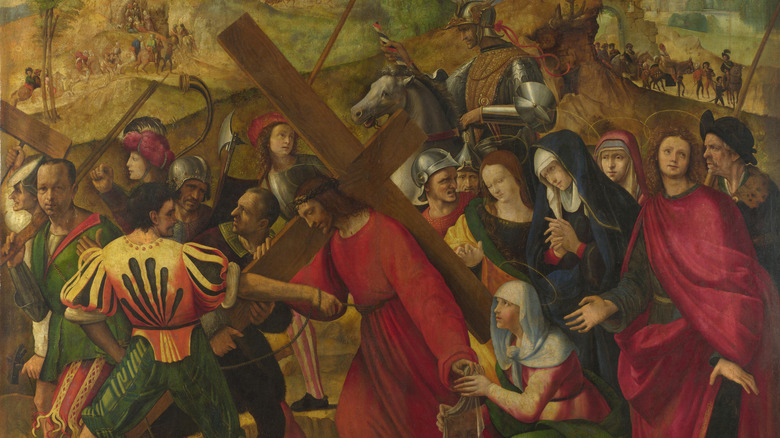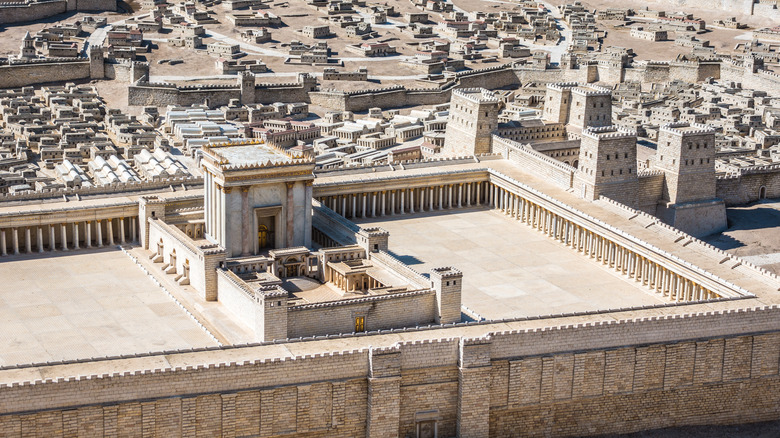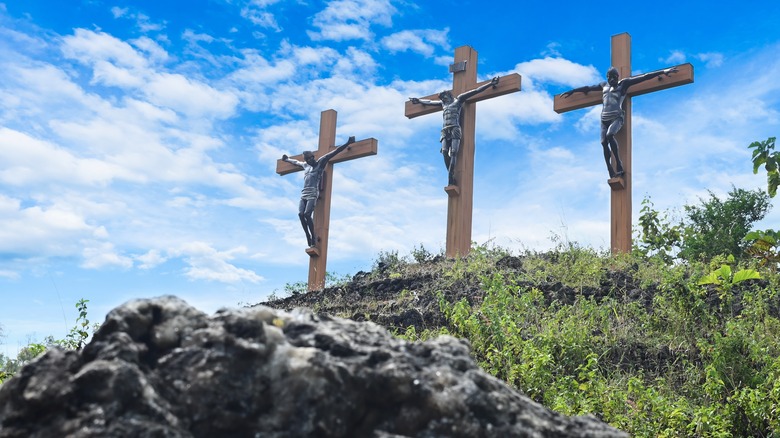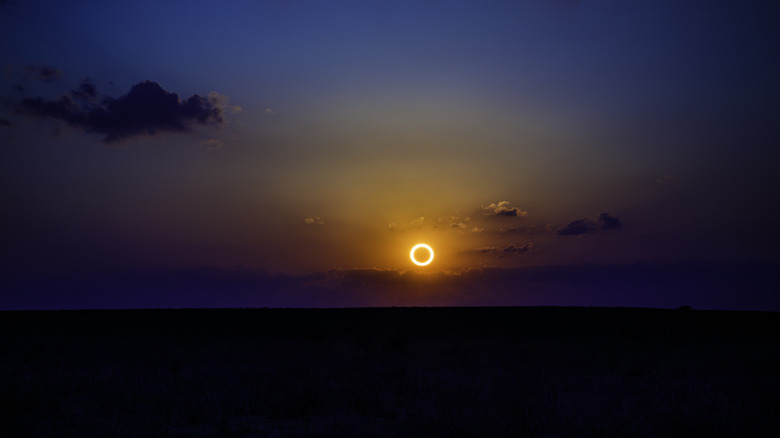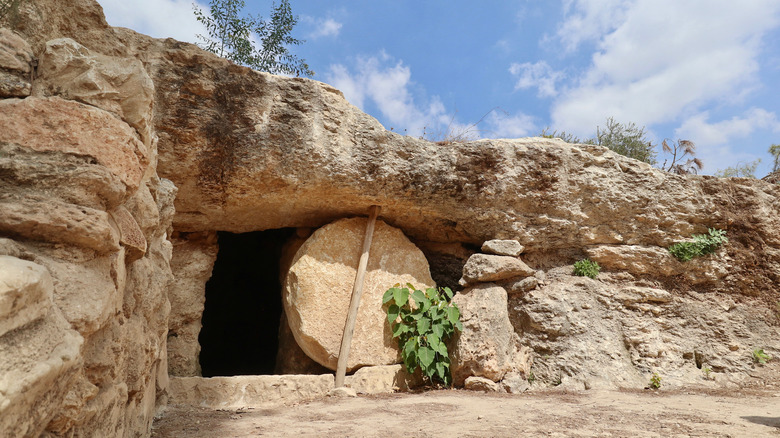What It Was Like The Day Jesus Died
Few days have resonated for so long and so profoundly in world history as the day of the Crucifixion of Jesus Christ, an event that set in motion the transition of a small Middle-Eastern breakaway sect of Judaism into Christianity, the largest religion in modern times, with followers that eventually numbered in the billions. While biblical scholars may disagree over the facts, whether there were any eyewitnesses, or if the Crucifixion even happened, there's no denying that the day as commonly understood would have been momentous as it was horrific to many in attendance.
According to the Christian Bible, around two thousand years ago, the Roman authorities of Jerusalem, then within a province of the Roman Empire, sentenced Christ to death by one of the cruelest methods of execution at their disposal: crucifixion. It took place on an auspicious date, too, during the Jewish festival of Passover, and near Judaism's holiest site, the Second Temple of Jerusalem.
Many cultures throughout the ages since have viewed and depicted the Crucifixion through their own unique lens, but what would that day have actually been like? Let's slip on some sandals, step into a time machine, and travel back to the dawn of the first century, to see what it was like the day Christ was crucified.
What was the actual day and date?
Unlike so many other notable events in history, we don't have a unanimously agreed date for Jesus Christ's crucifixion. Instead, many have turned to scripture and tried to reconcile the information contained therein with other historical records. This has proven even trickier than it sounds, not least because the Bible does not appear to agree exactly when Christ was executed. The Gospel of Mark puts the Crucifixion on the day of Passover, which in Jerusalem would have been on a Friday. On the other hand, the Gospel of John appears to describe it happening the day before.
Nonetheless, we can at least say the Crucifixion was on or around Passover, which can fall in either March or April — though it was most likely April — but what about the year? This, too, has been and continues to be debated among biblical scholars, but most tend to land around the early A.D. 30s.
One surefire non-scripture source for an exact date, even down to the hour, would be an astronomical event, and there might be one described at the time of Christ's death. Both Mark and Luke describe darkness falling over the land for several hours in Christ's last moments, and for some, this sounds very similar to an eclipse. Unfortunately, according to astronomical data, this still leaves us two years to pick from: either A.D. 29 or A.D. 33. So while we may not be able to pin down the exact date, the good news is that we still know plenty about that general time period.
Jerusalem during Passover
Exact dates notwithstanding, the New Testament is quite clear that Jesus Christ died in Jerusalem during Passover, and for that city, it was a busy period indeed.
In the early A.D. 30s, as it is now, Jerusalem was a Jewish holy site and host to many pilgrims from regions far and wide. It was also a bustling city, although its estimated population of 80,000 in Christ's time was a small fraction of today's, which in mid-2024 is estimated to be a little shy of 1 million (per World Population Review). Nevertheless, while modern-day Jerusalem is on the smaller side for a Middle Eastern city, in the first century, it was one of the largest. And during Passover, when pilgrims arrived en masse, its population may have as much as tripled.
Such an influx of people over a relatively short period would tax most modern cities, but for one in classical antiquity, without modern conveniences, one might think it would have been overwhelming. However, while Jerusalem may not have had 21st-century plumbing in the first century, it did have well-constructed sewers, and in the preceding century, the city had undergone major renovations under King Herod the Great, before his own brutal death. And all those pilgrims? It turns out that many of them probably would have happily camped out in the surrounding hills. Either way, for a first-time visitor at the time, Jerusalem would have been hopping.
Where the crucifixion took place
The New Testament maintains that Jesus Christ was crucified in a location called Golgotha, which in Aramaic ominously means "place of the skull." Today, the spot is marked by the Church of the Holy Sepulchre, at the end of a path — the Via Dolorosa, or "Sorrowful Way" — leading from the site where Christ was said to have been sentenced by Pilate. However, the church is located within the city walls, while the synoptic Gospels indicate that Christ was crucified outside of the city.
Over the last two centuries, numerous excavations around the Church of the Holy Sepulchre have given credence to the theory that Jerusalem's city walls did not always extend so far, and so would closer match the biblical narrative. For one, while archeologists were unable to find a wall large enough to be considered a true city wall, which in the first century would have been very thick, a wall of sorts was found. But it is the evidence of quarrying and agriculture that lends greater legitimacy to the location, as well as it being atop a small hill.
It is worth considering why an exposed location, just outside a city, would be a suitable location for execution. The Roman occupiers of Jerusalem and the surrounding kingdom of Judea dealt harshly with criminals, and indeed any who would dare pose a threat to their rule. Crucifixion was deliberately slow, brutal, and highly visible. Placing the dying condemned in such a public place, where there would have been any number of people passing by, would greatly amplify its deterrent effect.
What witnessing a crucifixion was like
The Romans didn't invent crucifixion, with the practice dating back well before them, but they certainly made it their own. As forms of execution go, nailing someone to a cross and leaving them to die is exceptionally cruel. But with crucifixion, the Romans were not just seeking to kill the condemned victims; they were also making a spectacle and an example of them. For the intended audience of Roman subjugates, it was true psychological warfare.
While Jesus Christ's experience largely agrees with other historical examples, there are a few aspects that may not be so familiar to everyone. For starters, depictions of Christ during the Crucifixion allow him some modest clothing, but this was unlikely to have been allowed, as victims were typically stripped to humiliate them. Scourging — a vicious whipping and beating — was followed by another public debasing, where the condemned had to carry the instrument of their doom to their place of execution. But this was not the entire cross that they had to carry, along a path lined with spectators, it was just the crossbeam.
After being crucified, death did not come quickly. It could take as long as four days, with the victim's breathing becoming increasingly difficult due to their hung position. It was also typical for the dead to be left on the cross, denied a proper burial, and left for the elements. Although crucifixion was reserved for the lowest non-Roman citizens, such as enslaved people, thousands still met this grisly fate, especially in Judea during the first century. So while people passing by might not have been shocked by the event itself, the reality of it would have been harrowing.
Events took a turn for the unusual right after Jesus died
According to the New Testament, when Jesus Christ died, several extraordinary events occured, some of which may have historical legitimacy. One intriguing idea is that a solar eclipse may have taken place during the Crucifixion, as described in the Gospels of both Mark and Luke, when "darkness came over the whole land" for several hours. Solar eclipses only last a few minutes, but still, there are two candidates for such an event: one in A.D. 29, and another in A.D. 33, both within the time frame that the Crucifixion is believed to have occured.
Natural phenomena at ground level are also documented in Matthew, which relates: "The earth shook, the rocks split and the tombs broke open." That sounded remarkably like an earthquake to some, and in 2012, an article in International Geology Review (via LiveScience) claimed to have verified that, with evidence of a significant earthquake having taken place between A.D. 26 and A.D. 36. Jerusalem happens to sit in a seismologically active area, and has suffered many devastating earthquakes throughout its history.
As if earthquakes and solar eclipses weren't enough, the Gospels also include a couple of spookier occurrences in the immediate aftermath of Christ's death. The first is the splitting in two of the Temple curtain, as related in all three synoptic Gospels (Mark, Luke, and Matthew), which some biblical scholars say is purely symbolic. And then there's the truly supernatural account in Matthew, when, after the aforementioned maybe-earthquake, a horde of resurrected saints emerge from the presumably exposed tombs and roam around Jerusalem.
The body of Jesus is recovered and entombed
Normally the crucified were left to rot and be eaten by animals, and their remains thrown into a pit alongside common refuse. This was a deliberate act and in line with the intent to publicly humiliate the victims of crucifixion. But according to the Gospels, Joseph of Arimathea — a wealthy and prominent member of the Jewish community — got permission from the Roman authorities to take Jesus Christ's body down and bury him before the Sabbath, which was the next day.
Some biblical scholars have doubts about this account by the Gospels, as there is little to suggest that the Romans would about-face on their own traditions and give consideration for local customs. But even in a political hot-spot like first-century Judea, it is not impossible.
The Gospels describe how, out of the three men crucified that day, only Christ died before the Roman troops decided to break his legs, so his body was removed from the cross intact. As scripture further relates, his body was then wrapped in linen, and placed with a large amount of fragrant spices into its intended final resting place. According to the Gospels, this was in a tomb, located outside of the city — not unusual in the region at that time, at least for those who could afford it, like Joseph of Arimathea.
